A turkey came to visit on our sea day between Rio and Salvador.
And we went to the Crown Grill with Barb and Ed.
My favourite thing to order is the French onion soup and I wasn’t disappointed.
Great table by the window…the steaks were amazing.
Not to mention the yummy desserts! Their version of s'mores and a cheesecake...
We sailed into Salvador and it looked quite nice. The population of Salvador is 2.8 million.
Our ship reflected in the building at the port…
Brazil was originally populated by Indians who numbered 5-6 million before the white men came. Currently, there are about 400,000 mainly on reservations.
Salvador, the capital of the state of Bahia, has miles of scenic coastline with tranquil beaches surrounded by tropical vegetation. The city is known for its numerous churches—over 165 at last count!
Founded in 1549 on the Bay of All Saints, Salvador was Brazil’s capital in 1763. The early colonists established sugar and tobacco plantations that gained the region fabulous wealth. These same colonists used their skills brought over from Europe to build their businesses, churches and public buildings in the baroque style. Today, Salvador is home to the largest concentration of baroque colonial architecture in Latin America.
One of the many churches we could spot just from our balcony, but this one looked like it had trees growing out of it.We soon learned why...
Looked like we were getting supplies, but they were loading them into the warehouses on the pier instead.
We opted for a Princess tour as we heard it’s not a great area and there aren’t a lot of English taxi drivers. We started out on our city tour…it looked quite nice.
Looks like a giant bra…
This elevator was built to take people from the lower city at sea level to the upper city.
This old building was being renovated and so far everything still looked good.
But then we started seeing a lot of these buildings. The old city has been declared a heritage site because of the architecture so the buildings can’t be torn down, but there isn’t any money to renovate them, so they just continue to deteriorate. (This explained the trees growing out of the church!) We could see that some people were living in some of the buildings.
Not such a pretty downtown…between 60-70% of the people are deemed to be poor. Many originated from the African slaves that were brought to work the sugar and tobacco plantations. Today 90% of the poor population is black. Brazil was the last country to abolish slavery in 1888.
The buildings in the upper city have a wonderful view. You could see the very pretty yacht area with a Martello tower.
A lot of the shops have iron gates over the door, even when they are open.
The theatre looked lovely…
In an area of beautiful condominiums…
This is the palace of the Governor of the State of Bahia. Brazil gained its independence from the Portuguese on September 7, 1822.
Uniquely shaped telephone booths in Brazil called orelhao (big ear)...
We noticed several forts along the way…
Before stopping at this one, the Fort of St. Anthony.
It is the oldest fort in Brazil, built in 1549, and is now a naval museum. The lighthouse was erected in 1889.
There was a huge motorcycle rally and the media was filming them.
Barb is sporting a new hat she just bought…
Jim with our bus in the background. The bus was beautiful—very comfortable, clean and air conditioned.
Jim and Ed…we are “sticker people” for today!
It wasn’t too hot…yet!
Dirk, our tour guide, was originally from Belgium. I’m not sure what brought him to Salvador. He was an excellent tour guide, but talked so much and threw out so many facts that after a while we went on overload.
Carnival had just finished here as well, and there were still stages and tents all over the city. Salvador has the largest carnival in the world with over 1.5 million people partying in the streets.
Salvador may be poor, but they have miles and miles of beautiful beaches.
He was cute…not sure what business it was advertising…
And more beaches…there were lots of soccer games being played.
A clean park…
It looked very inviting!
This open air shopping mall has declined in popularity over the years. It has taken up a prime location on the beach, but is slowing going bankrupt.
Some cute murals…
Brazil has two-tiered systems for health and education. The public education system is still deemed to be adequate, but the public health system is not. One of the many poorer neighbourhoods we drove through…
The Congress building is a major expense for the taxpayers. It was an architectural mistake in that it was built out of steel which, because of its location near the sea, is rusting. Now the city is trying to sell it without much success.
Nice highways…they will be hosting games during the 2014 World Cup and are trying to develop some infrastructure and a new stadium before then.
A different church!
He looked so cute…price of gas is about $6 a gallon!
Subway!
Many people in this area still practice the African religion known as Candomble. These statues represent the gods dressed in various colours, each colour specifying a particular god or saint.
A flame tree!!
The orphanage…
The train station is in a pretty seedy area. They have a lot of work to do before the World Cup in 2014 and the Olympics in 2016.
Another of the many churches…
This guy was meticulously arranging his produce…
And yet another church…
One of the nicer homes in the area…they all have fences around them.
I never saw so many car repair shops in my life…every street had 2 or 3!
This lovely view on one side…
With this view on the other. You can tell these are the wealthier homes as they had fences around them.
These businesses may have been open. You would only be let in if the owner wanted you to come in.
Our next scheduled stop was the Church of Bonfim. It has been the site of pilgrimages for many years and is beloved by the Bahian people. It is believed to have special curative powers and those seeking divine intervention often leave a photo of themselves or a replica of a body part that was healed inside the church. The fence in front of the church is filled with colourful ribbons.
You can also take one of these ribbons and tie it around your wrist with three knots. When it falls off, your prayer will be answered…if you believe.
The interior…a rather strange mixture…
Beautiful paintings…
The room with the pictures of those who prayed for intervention. It could be prayers for anything from good health to a new motorcycle.
And the body parts…if your hand was healed, you left a hand. Bizarre!
A wall of beautiful traditional ceramic paintings…
The ceiling…
Back on the bus, Dirk explained that these children are from the poorer neighbourhood and they hang around the church and sing hymns for money. They probably did all right taking up a collection on the bus.
Cute!
This is the local St. Joaquin market…it really reminded us of Africa.
There were trucks and trucks of coconuts being unloaded…
And then our final stop of the day, the Mercado Modelo, the tourist market. I bought a couple of towels and some cashews. It was reminding me more and more of Africa…it was steaming hot in there.
And then we headed back to the ship. There are some lovely old buildings that have been restored.
But you have to wonder about these buildings that are only shells now. I can't imagine them ever being restored and yet no new buildings can be constructed as it is in the heritage site.
A funicular…
Our next stop is Fortaleza. We’ve heard even less good things about it, so we will stick with the easy Princess city tour.
Sailing away…lots of church steeples…
It gets dark very early here as we were almost at the equator.
The ship’s bridge directly above us with a half-moon shining in the sky.
This ferry boat sailed by and the camera flashes were going. I imagine we are a pretty sight.
And we returned early from dinner to find Gina making her latest creation.
A cobra!
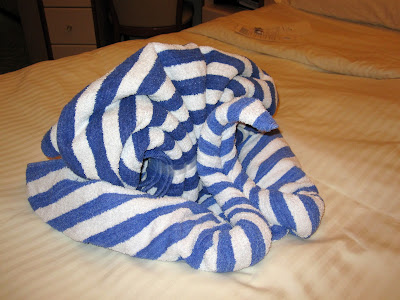




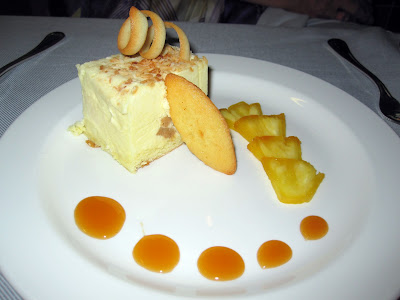






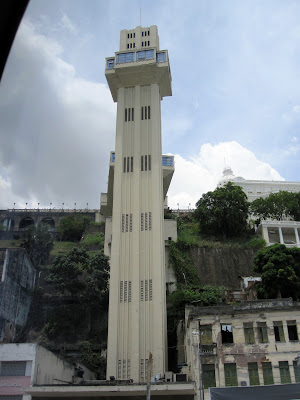






























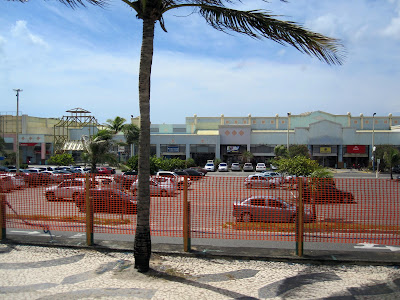

















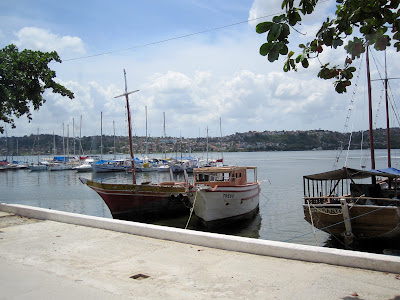










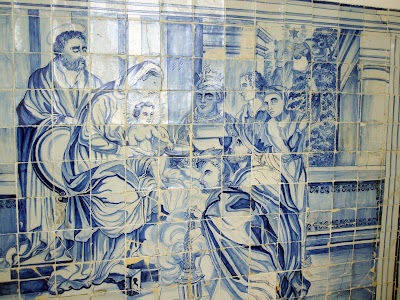






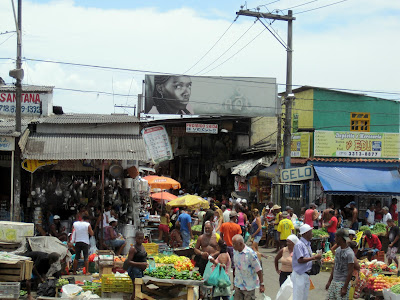















No comments:
Post a Comment